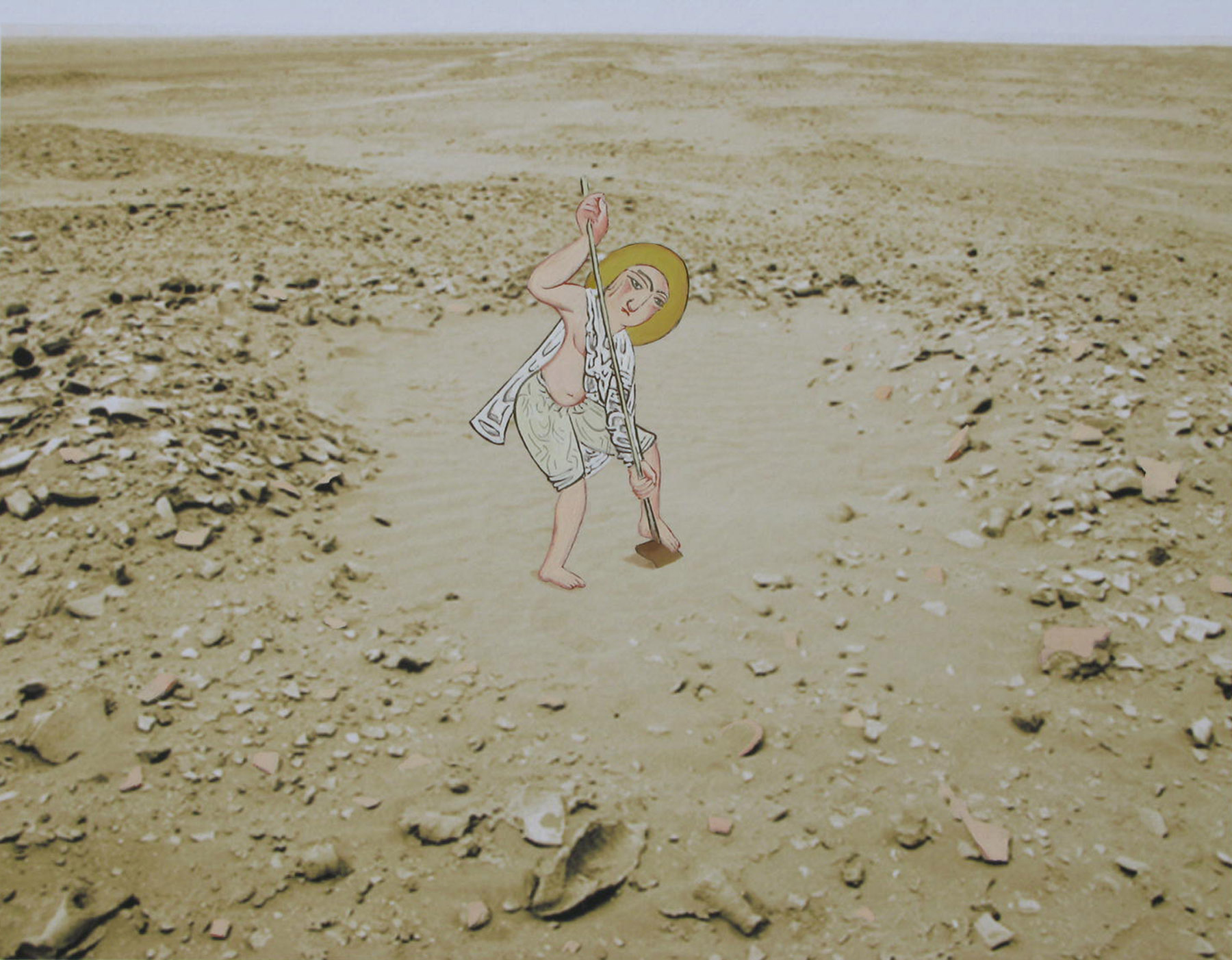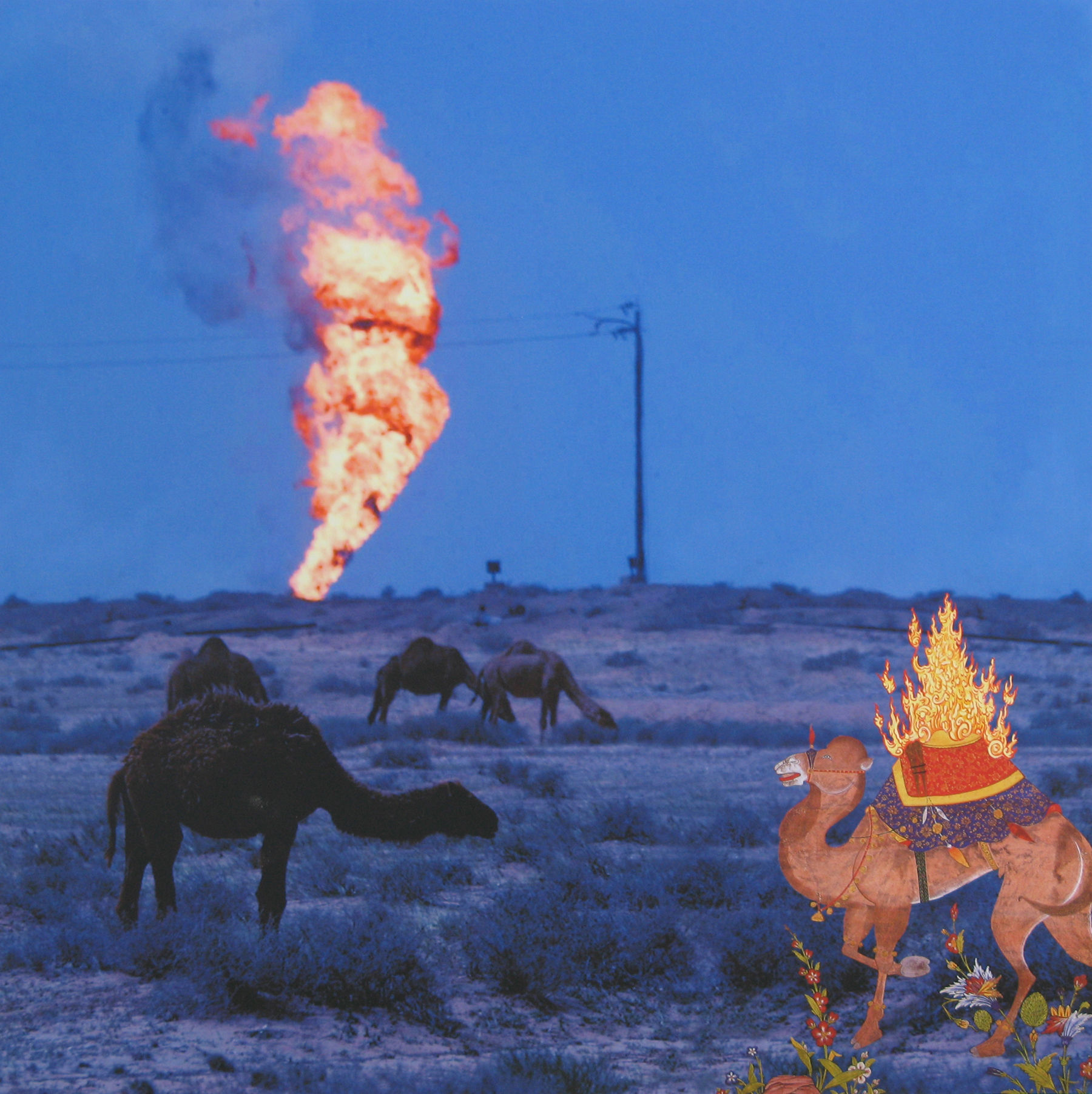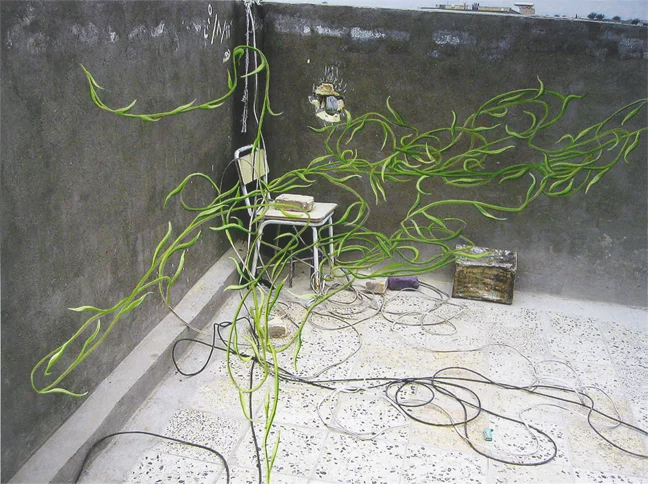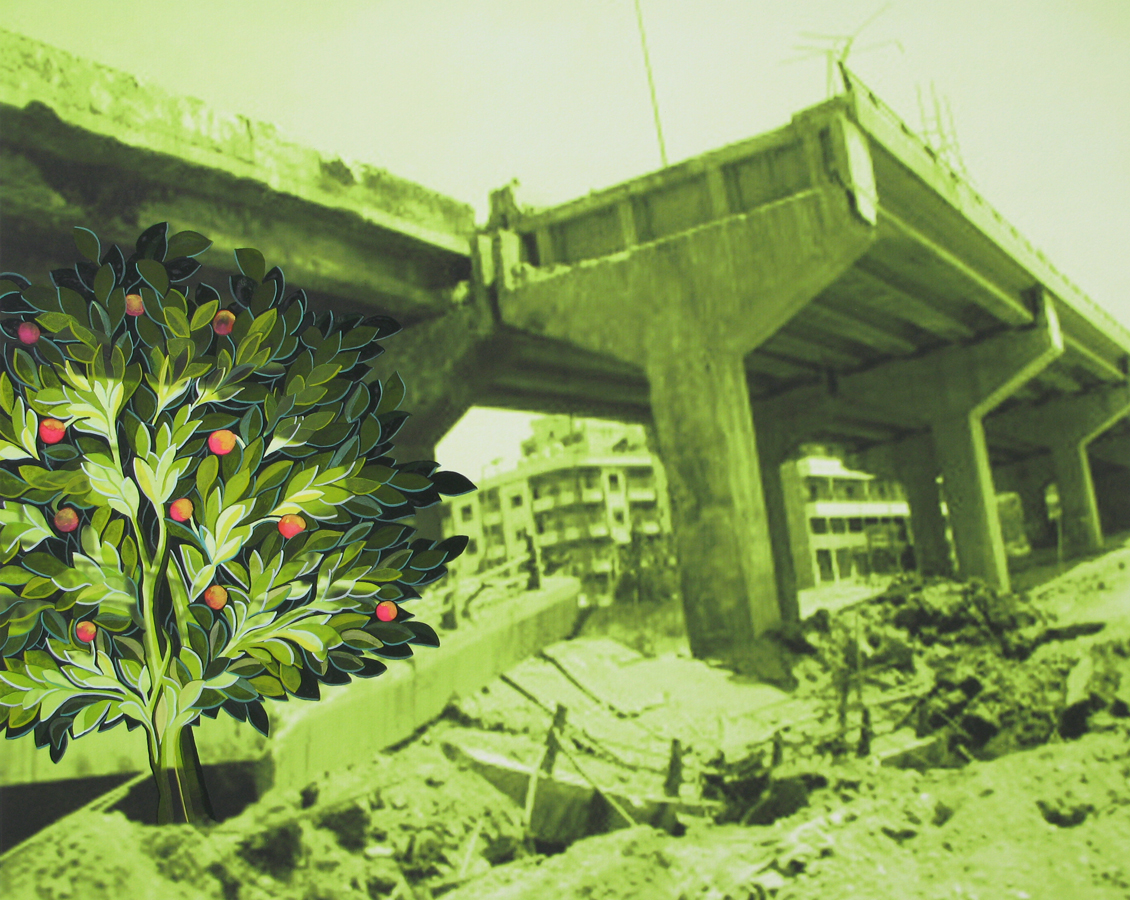R&R(...&R), 2006 - 2011
All works in this series are gouache on archival digital print on Hahnemühle paper.
Structures, both physical and social, come undone when we resort to violence. Responding to the ongoing disasters of war and the policies and conditions that lead to them, artists can condone or condemn. The challenge lies in finding a constructive stance. The R&R(…&R) project counters art historical and contemporary media representations of war with restorative interventions. Its title converts the military abbreviation for “rest and recuperation” to titles like “regret and restitution.”
R&R(…&R) culls images of regeneration from the art and architecture of areas in current or recent conflict. Referring to scenes of daily life, construction and cultivation, I paint passages of resurgence (from the workshops of Persian miniaturist Bihzâd to the court arts of Safavid Iran) over photographic scenes of devastation across Afghanistan, Iraq and the Middle East. Sources for these contemporary scenes are “documentary” images found on the internet — from military and news media sites, FLICKR and Webshots, and blogs by soldiers and others in the midst of war.
I am not deluded that these “restorations” offer any actual balm, but hope that they induce an empathic unsettlement, that they pose questions about our complicity in, as well as our seemingly miraculous recovery from, incomprehensible and often self-inflicted destruction.

RESTORATION: Red Balcony II, 2008
Gouache, pastel pencil, band-aids/Hahnnemuhle paper
66 x 42 inches
Every edge, ledge and railing of this Beirut building damaged by mortar fire in the 2006 War with Israel has been redrawn or solidified. Pink day-glo band-aids are pasted over places where the walls have been punctured; some send out concentric rings that can either signal survival or distress.
Photo source: http://www.habeeb.com/lebanon.photos.18.beirut.war.destruction.html

REMORSE: White Curtains 2006
Gouache, ink, pastel pencil, archival tape/Hahnemühle paper
66 x 42 inches
Photo source: http://www.habeeb.com/lebanon.photos.18.beirut.war.destruction.html

RECONSTRUCTION: MAGENTA BEIRUT, 2007
Gouache on archival digital print/Hahnemühle, 16 x 20 inches; 24 x 28 inches framed.
To show a culture building itself, a ghostly version of a scene from Bhizad’s 15th c. Building of the Great Mosque of Samarkand is painted over an altered internet image of rubble left by a 2006 Israeli air strike in Beirut. This structure has its own history of decay and rebirth that is entwined with conquest and commemoration. Fearing he would die before its completion, the Persian conqueror Tamerlane (who referred to himself as the Sword of Islam) ordered the Bibi Khanum Mosque in Samarkand to be built in haste. Consequently, it began falling apart prematurely and existed as ruins for almost six centuries. After 1974, it was rebuilt by the Soviets albeit greatly reduced in size. Perhaps this structure is an object lesson on the impetuous, on thinking before we act, especially when it comes to guerilla or state-sponsored warfare.

REVEAL: Pastoral, Flora and Fauna, 2007
Gouache on archival digital print/Hahnemühle paper, 14.25” x 17.25”, 24 3/8” x 27” framed; Border from illumination for Mughal emperor Shâh Jahân, c. 1635-40, Sadruddin Aga Khan Collection, Geneva; photo source (now broken link), later sourced to Joshua Trujillo/Seattle Post-Intelligencer, “Bombs from American B-52s explode near Taliban tank positions on Kala Kata hill near Dasht-e-Qalaeh, Afghanistan.”
http://www.nadir.org/nadir/initiativ/agp/campanas/stopwar/afghb52bomb1.jpg
Plumes from bombs in Afghanistan rise from a seemingly empty landscape. They are framed by flora and fauna to recall a more idyllic, peacetime nature.

REBUILD: Mdeirej Bridge, 2008
Gouache on archival digital print/Hahnemühle paper, 16 x 20 inches; 24 x 28 framed.
Border from A Chinese Dignitary, a copy in Istanbul, probably made in 15th century Tabrîz, Library of the Topkapì Sarayì Museum, Istanbul
Rebuild: Mdeirej Bridge takes its decorative border from a Persian portrait of a Chinese dignitary, evidence of cultural transmission and exchange, suggesting a dynamic culture not fixed in one time or place. Its floral motif frames a bombed and fallen bridge span, but it is not meant to decorate the damage. David Levi Strauss questions the idea that the more transformed or “aestheticized” an image is, the less “authentic” or politically valuable it becomes. He asks “Why can’t beauty be a call to action?,” asserting that to “represent is to aestheticize; that is, to transform.” He sees aestheticization as “one of the ways that disparate peoples recognize themselves in one another.”5
Appropriating passages from cultural traditions other than my own has its risks; it can mimic the very idea of conquest that I am critiquing. Nonetheless, as an admitted outsider, I am trying to bridge cultural divides that are both real and constructed. Incorporating imagery from the former Islamic Empire is one way of dispelling prevalent stereotypical notions of its contemporary regions and religions as solely proponents of malignant fundamentalism. My selections counter the media’s endless images of militancy and martyrdom, juxtaposing the highest aspirations of a culture with evidence of its eradication.

REPEL, 2010
12 x 21.5 inches, 19.3.75 x 28.25 inches farmed.
Gate derived from The gatekeeper denies entrance by one unworthy of the garden in the Bustân by Mîrak or Bhizâd, 1488–89, National Egyptian Library, Cairo. Photo: U.S. Army soldiers from A Company 3rd Battalion 7th Infantry Regiment search through a bomb-damaged palace of Saddam Hussein in Baghdad Monday, April 7, 2003 after entering the Iraqi capital in force Monday.(AP Photo/John Moore) http://www.flickr.com/photos/7797961@N08/3408924983/
This scene of Saddam Hussein’s bomb-damaged palace in Baghdad is modified from an AP photo posted on FLICKR. The figures are derived from The gatekeeper denies entrance by one unworthy of the garden in the Bustân (The Orchard) by Mîrak or Bhizâd. Who is worthy of entering the garden and to whom does the garden belong?

ROAD REPAIR (Halat), 2006
16 x 20 inches
This work shows a road destroyed in 2006. The rebar grid substructure has been painted back in to figuratively begin rebuilding the road. The yellow circles are enlarged projections from the distant headlights. They sit right on the surface, in the viewer’s realm, possibly implicating us as co-sponsors of the destruction or as passive witnesses.

RESTORATION (Threshold I), 2006
Gouache on archival inkjet print on Hahnemühle paper, 10 x 16-1/8 inches; Photo source of Khiyam, Lebanon after Israeli bombing August 21, 2006 (altered): Flickr, M. Asser http://www.flickr.com/photos/masser/221392959/ FRAMED 16 7/8 x 22 5/8 inches
Rubble renders place anonymous; it eradicates all distinguishing features. In Restoration, the transparent white tracery of a mashrabiya (the ornate wooden latticework prevalent in traditional Arab architecture dating to 12th century Baghdad) balances precariously among piles of dust, debris and concrete. The presence of this ornate detail insists that the targets of war are neither faceless enemies nor sites devoid of culture. They are not just anywhere but somewhere, not just anyone but someone.

Reveal: Opening Act, 2007
Gouache and graphite on archival digital print/Hahnemühle paper, 16" x 10”. FRAMED 25 5/8 x 19 1/8 inches
Curtains from Two Seated Men from the Maqamat of al-Hariri of Basra, Syria, 1237
A painted detail of drapery suggests a bygone domestic tranquility against three stories of rooms left exposed bya gaping hole in the wall. The curtains are the same as those that frame two seated men in a 13th century illustration by al-Waiti for al-Hariri of Basra’s “Maqamat,” a set of 50 short stories named after 50 Muslim cities that is one literary pinnacle of the Arabic language. Al-Wasiti’s illustrations were highly regarded for portraying a specific world and capturing aspects of daily life. Inserting details of home decor resists the anonymity that war confers on place and person.

REMIND: FLORA AND FAUNA, 2007
16 x 10 inches, 26 x 19 inches framed; TV garden from Prince Bahrâm-I Gor listens to the tale of the Princess of Khwârazm beneath the Green Pavilion illustrated by Shaykhî to Nizâmi’s Seven Icons for Sultan Ya’qûb of the Turcoman clan of the White Sheep, Tabrîz, c1478–90, Library of the Topkapì Sarayì Museum, Istanbul; South Lebanon photo: M. Asser
A stork flies above and oblivious to the wreckage of an unexploded bomb that has crashed through the ceiling of a Lebanese home. Its flight contrasts the dead and dangerous weight below. The stork is revered in Islam for making annual pilgrimages to Mecca while English symbolism assigns it conflicting associations with the maternal or the tyrannical. A detail of a painted garden from a Persian miniature fills the silent TV screen, hearkening to a more idyllic or paradisiacal time.

REHYDRATE I, 2008
Gouache on archival digital print on Hahnemühle paper, 10 x 15 inches; water motif from illustration by Master Ahman Mûsâ in a Mi-râj-Nâmeh (“Book of the Mystical Ascension”), Tabrîz, second quarter of the 14th century, Topkapì Sarayì Museum Library, Istanbul.
Stylized waves lap impossibly at edges of craters in Lebanese roads bombed in 2006, merging the transcendent with the mundane.

REHYDRATE II, 2008
Gouache on archival digital print on Hahnemühle paper, 10 x 15 inches; water motif from illustration by Master Ahman Mûsâ in a Mi-râj-Nâmeh (“Book of the Mystical Ascension”), Tabrîz, second quarter of the 14th century, Topkapì Sarayì Museum Library, Istanbul.
Stylized waves lap impossibly at edges of craters in Lebanese roads bombed in 2006, merging the transcendent with the mundane.

REPAIR (PROSTHETIC), 2008
Gouache on archival inkjet print on Hahnemühle paper, 8 x 6 inches. Photographic source of broken pottery in Larsa, southern Iraq by Joanne Farchakh.
http://oi.uchicago.edu/OI/IRAQ/dbfiles/farchakh/farchakh_172.htm
"History in Pieces": But many items were stolen or destroyed by looters. Here, broken pottery lies in the dust at Larsa, a major Sumerian capital in today's Nasiriya, in southern Iraq
http://news.bbc.co.uk/2/hi/middle_east/4461755.stm
Many items were stolen or destroyed by looters at unsecured archeological sites during the Iraq War. Here, broken pottery lies like broken limbs in the dust at Larsa, a major Sumerian capital in today's Nasiriya, in southern Iraq. A hand-painted modern prosthetic arm occupies the foreground as an inadequate replacement for the scope of loss.

REGENERATE: Gardening the Robber Hole, 2007
7.625 x 10.125 inches
A gardener from the 12th c. Book of Antidotes of the Pseudo Galen, in the style of the first school of Baghdad, breaks earth with his shovel. He digs in a field of “surface scatter,” the term for remnants left after raids on archeological sites. The bare triangle of sand surrounding him indicates a “robber hole,” the location of a stolen treasure, subsequently filled by sand. The gardener begins cultivating anew; his action is another kind of “antidote.”

RESTORATION: HAND SAIDA, 2006
4 x 6 inches , 10.75 x 12 3/8 inches framed

Restoration (Hand Saida), 2006
Gouache and mixed media on archival inkjet print on Hannemuhle paper, 4 x 6 inches

RECONSTRUCT: CASTLES IN THE SKY, 2007
20 x16 inches; Source: Building of Castle Khawarnaq, illustration by Bihzâd for Nizâmi’s Seven Icons; Khamseh of Nizâmî, Herât, 1494-95, British Library, London

RESUME: PARTLY CLOUDY, 2008
10 x 7.25 inches, 16 7/8 x 13.75 inches framed; Bird from illustration (added in Isfahân c.1609) by Habìbul Mashhad for the manuscript of Attâr’s Parliament of Fowles, illustrated1487–88 in Herât by Bihzâd, Metropolitan Museum of Art, New York

REDOUBT, 2010
8 x 6 inches, 15 x 12.625 inches framed. Dome derived from Bahram Gur and the Indian princess in the black pavilion from a Khamsa (Quintet) by Nizami mid 16th century, Safavid dynasty. Opaque watercolor, ink, and gold on paper, 31.1 cm high 19.7 cm wide, Smithsonian; photo source: Al-Askari Mosque in Samarra, http://www.echostudiochicago.com/learn/golden-mosque-falls
The Al-Askar Mosque in Samarra, Iraq is one of Shiite Islam's holiest sites as it houses the tombs of two 9th c. imams, direct descendants of the Prophet Muhammad. Sunni extremists destroyed its dome in 2006, the first time that internal forces had targeted one of the country's central religious symbols. Its two remaining minarets were destroyed in a 2007 bombing by al-Qaida operatives. Both incidents caused widespread rage and panic amongst Shiite Muslims and ensuing sectarian violence.
A dome descends upside down from the sky in Redoubt, acknowledging the upheaval. Its point is like a brush, with potential to visualize restoration and a time of greater tolerance. Even though the golden dome and minarets of the Al-Askari Mosque were restored in 2009, divisions of faith, fanned by the tensions of occupation and war, continue to threaten sites both secular and sacred.

WRESTLING OVER RUIN, 2007
25 3/4” x 31 3/8” framed; Baghdad photo source: Sean Smith, Guardian
Wrestling Over Ruin represents violence arising from violence in an eternal struggle between two dragons battling in the heavens over the U.S. bombing of Baghdad.

RESILIENCE II, 2008
18 x 24 inches. Grille pattern from tomb of Muhammed Ghaus in Gwalior (16thc); background photo source: Webshots: johndrummer16, album#5 Iraq 2005.
http://travel.webshots.com/photo/2364768380062712657DkxjoY
John Drummer posted this image as an 11B "Infantryman" in the 82nd Airborne Division. His last available posted album was titled ‘Good Times”, September 25, 2009. The gap between Ghaus, a sainted Sufi author of “The Ocean of Life” and Saddam Hussein, a brutal dictator, reflects the distance between our highest aspirations and most tragic failures.

REMORSE (THRESHOLD), 2007
Gouache on archival inkjet print on Hahnemühle paper, 10 x 16-1/8 inches; Photo source of Khiyam, Lebanon after Israeli bombing August 21, 2006 (altered): Flickr, M. Asser http://www.flickr.com/photos/masser/221392959/
Transparent white latticework balances precariously amidst the 2006 rubble of Khiyam, Lebanon. Bombing eradicates anything that distinguishes one culture, population or place from another. Rebar, concrete and dust all look the same when collapsed in mangled heaps. Inserting specific ornate architectural details counters the anonymity conferred by ash and rubble. Mashrabiyas, the carved perforated wooden screens of Islamic architecture dating to 12th century Baghdad, are among such details, reminding us that this is not just any place, but some place.

REFRASH (WATERFALL), 2007
Gouache on archival digital print/Hahnemühle paper, 20 x 16 inches. Water motif from Shãhnãmeh fragment, Tabrîz, 1370, Folio 65b, Tabrîz, Istanbul

REND, 2013
Gouache on archival digital print/Hahnemühle paper, 13.5 x 18 inches
Photo source: Rosa Schiano, http://palsolidarity.org/wp-content/uploads/2012/12/41.jpg
Israeli “Pillar of Defense” military offensive in Gaza on November 12, 2012 that killed 72 people including four children in the Al Dalu home on Nasser Street; animal motif derived from Tree of Life mosaic (8th c. Umayyad period) that depicts the mythical tree with two deer grazing peacefully on one side and a third deer attacked by a lion on the other, in the diwan of the bath complex at Khirbet El-Mafjar/Hisham's Palace in Jericho, West Bank

RE_ENTER (PASSAGE), 2008
27 x 18 inches. Source: FLICKR:banehfc
Transparent white tracery of a mashrabiya (the ornate wooden latticework prevalent in traditional Arab architecture dating to 12th century Baghdad) hovers in or beyond an open doorway of a room with mortar-scarred walls. The architectural detail may hover as an apparition or suggest continued vulnerability. Inserting specific references (from painting, architecture and literature) into contemporary media images insists that the targets of war are neither faceless enemies nor sites devoid of culture. They are not just anywhere but somewhere, not just anyone but someone, not distant tribes, but complex societies with their own hopes and dreams.

RESOUND, 2011
Screenprint with solvent transfer, 18 x 15 inches paper size, 14.5 x 11 inches image size. Edition of 20.
Sources: FLICKR_pt_stebbing photo stream of Iraq; “The Fairy Queen enthroned in her theophany atop the Tree of Life which springs from the fount of life”, study for an illustration to Nizâmi’s Tale of the Princess of the Black Pavilion, Tabrîz or Qazwîn, mid 16th century. Freer Gallery, Washington D.C. 50.2. The Black Pavilion is the first of seven tales that comprise Nizami’s 12th century book of poems “The Seven Beauties.” It embodies eternal human experiences such as love, desire, frustration and melancholia.
Printed by RED LETTER PRESS, Youngstown State University.

RESTORATION (Protection), 2007
Gouache on archival digital print/Hahnemühle, 16 x 24 inches
Islamic patterning typical of mashrabiyas (ornate wooden latticework prevalent in traditional Arab architecture dating to 12th century Baghdad) fills bombarded windows of a contemporary building in the Middle East.

RESPITE, 2007
Gouache on archival digital print/Hahnemühle paper, 10.125 x 15.125 inches; garden details from Five Youths in a Landscape, Tabrîz, c.1520, Sackler Gallery and from Bahrãm Chubin listening to the prophecy of a sorceress, from a Shãhnãmeh of Firdawsi, Shirãz(?), 1585, Topkapì Sarayì Museum, Istanbul, Revan 1548, fol. 489a; photo of Fallujah

RESTORATION: BRIDGE I, 2007
Gouache and metallic acrylic on archival digital print/Hahnemühle, 16 x 20 inches. Source photo: http://www.habeeb.com/lebanon.photos.18.beirut.war.destruction.html
Aspirational repair of the bridge north of Beirut destroyed by an Israeli air strike early on Friday August 4, 2006.

RESOURCE: BASRA 2010
16.25 x 23.5 inches 25.75 x32.5 inches framed. Sources: Basra University Central Library destroyed by fire, June 2003. http://archive.ifla.org/VI/4/admin/iraq2407/pages/BASBU5.htm; The library of Basra, miniature by Al Wasiti from "Maqamat" by Al Hariri, 13th century, Hulton Archive.
Collection of Leslie Brothers, Youngstown, Ohio

RESTORATION: MAAMELTEIN ROAD, 2007
Gouache and graphite on archival digital print/Hahnemühle paper, 16.125 x 20.125 inches.

ROARING AT THE RAID, 2007
7 x 10 inches. Lion from 14th century manuscript, Iraq. Photo source: Joanne Farchakh-Bajjaly.
http://oi.uchicago.edu/OI/IRAQ/dbfiles/farchakh/farchakh_049.htm

RISE: ACTIVE INTELLIGENCE, 2008
8.125 x 7 inches. Archangel, symbol of active intelligence, 16thc, perhaps from Uzbek Bukhârâ or Ottoman, Library of the Topkapì Sarayì Museum, Istanbul
In Rise: Active Intelligence, the image of archangel Jibreel or Surôsh (Active Intelligence) is superimpsoed over a contemporary war scene in Iraq. Glowing and hovering in an explosive fire that can be apocalyptic or annunciatory, the image of this angel is open to interpretation. One could infer an inherent critique of the erroneous “intelligence” that was used to justify a “pre-emptive” war. One could lament the absence, in this case, of “Active Intelligence” — one that provides divine, rather than idiotic, inspiration. One could heed Surôsh’s call to retreat from “Satan’s whispers” or all our evil will and deeds.

RECURRENCE: FLAMING CAMEL, 2008
Gouache on archival digital print/Hahnemühle paper, 16 x 16 inches. Camel from an illustration to the Falnameh, ‘Abd Ul-‘Aziz, Iran, Tabriz, 1550; photo source: http://news.webshots.com/photo/1118741950051644870WUJmaq
For this specific image, a photographic image of an oil fire from a Baghdad album by Coug91 on Webshots is altered and combined with a digitally collaged and hand-painted camel from a Persian miniature. The photographed and painted camels are both oblivious to the fire on the horizon, though one bears a flaming hump. It refers to Timur’s defeat of the Delhi Sultanate in 1398. Timur (or Tamerlane) was the 14th century Turco-Mongol conqueror of much of western and Central Asia. Faced with theDelhi Sultanate's 120 war elephants, Timur prayed to Allah, then attached straw to the backs of his army of camels. As the camels neared the elephants, Timur ignited the straw, propelling the distressed camels forward in wild terror. The frightened elephants ended up crushing many Indian troops as they fled in retreat. The confluence of the past and the present, the hand-made and the mechanical or digital, passivity and aggression all speak to contradictory forces at work in current quagmires, especially in Iraq and Afghanistan.

REARING IN THE RUINS, 2008
10.125 x 7.625 inches; horses from King Darius (Dârâ) and the Herdsman, illustration by Bihzâd for the Bustân. Photo source: Southwest Palace of Sennacherib: damaged winged bull in doorway at Nineveh http://oi.uchicago.edu/OI/IRAQ/dbfiles/farchakh/farchakh_142.htm
Collection of Kristen Accola, NYC

REVEAL: CRANES OVER JIVYEH, 2007
Gouache on Hannemuhle paper, 6 x 10 inches. Bird clouds from The combat of Rustam and Kãmus in Shah Tahmãsp’s Shãhnãmeh, attributed to ‘Abd al-Vahãb, c.1530, fol.271a, Tehran Museum of Contemporary Art. Collection of Paul Eiss, Pittsburgh.

REPERCUSSION, 2013
Gouache on archival digital print/Hahnemühle paper, 7.5 x 12 inches
Photo source: Rosa Schiano, http://palsolidarity.org/wp-content/uploads/2012/12/6.jpg
The Israeli “Pillar of Defense” military offensive in Gaza on November 12, 2012 that killed 72 people including Mzanar Abdallah, 20, and Amina Mznar, 80, an elderly woman sitting in the kitchen in her wheelchair at the time of the bombing. The plastic beaded curtain is painted as if propelled outward by its blast. If only it were a gentle breeze.

ROMANCING THE RUINS: NINEVEH, 2007
Gouache on archival digital print/Hahnemühle paper, 12 x 16 inches. Figure from Prince Humây before the palace of Princess Humâyûn of China” by Junayd for the early 14th-century romance, Humây and Humâyûn by Khwâjû Kirmânî, British Library, London. Photo source by Joanne Farchakh-Bajjaly: Southwest Palace of Sennacherib: damaged relief slabs.
http://oi.uchicago.edu/OI/IRAQ/dbfiles/farchakh/farchakh_149.htm
Prince Humay, on his pilgrimage from the ‘dusky’ realm of matter in the West [in this case, Syria] calls upon, the Princess Humâyûn who represents the spiritual East or ‘China,’ the horizon of the Godhead’s rising sun”.

REPLICATE, 2010
Gouache on archival digital print/Hannemuhle paper, 7.625 x 10.25 inches. 15 x 17.125 inches framed.
Photo source: FLICKR, ArmyofDude, Baqubah

REAP: FRUIT TREE, 2008
Gouache on digital print/Hahnemühle paper, 16 x 20 inches.
Tree motif from mosaic at Khirbat al-Mafjar, Jericho.

RESTORE: SARAFIYA STAR OVER THE TIGRIS, 2007
Gouache/Hahnemühle paper, 6 x 8.125 inches, 12 7/8 x 14 5/8 inches framed.
A 13thor 14th c. Iranian tile design spans the gap of Baghdad’s al-Sarafiya Bridge that was destroyed by a truck bomb in 2007. Pairing the elegant decorative geometry of Islamic design against the contemporary geometry of engineering points to the choices we make, how we direct our expertise and ingenuity.

REGRET: COUNTING THE WAYS, 2007
10 x16 inches

RABBITS IN THE RUBBLE, 2007
10 x 16 inches. Photo source: habeeb.com/beirut.war.lebanon.01.html
These rabbits are derived from Persian miniature paintings, playing whimsical representations of the past against a sober scene of contemporary destruction. The situation becomes all the eerier through an abandoned tricycle with its plastic rabbit head, the only intact item left standing in the rubble. Violence toward the innocent becomes all the more palpable, in a still place with no human presence.

REVEAL: YELLOW CRASH, 2008
Gouache and acrylic/ Hahnemühle, 16 x 10 inches. Sky details from illustration by Sultân-Muhammad for Nizâmî’s Treasury of Secrets in the Khamseh (Five Treasures) for Shâh Tahmâsp (Tabrîz 1539-43), British Library, London

ROMPING IN THE RUINS
13.625 x 9 inches

REVEAL: ROARING IN THE RUBBLE
13.625 x 9 inches

RECOVER: Illuminatins 2007
Gouache, ink, pastel pencil, archival tape/Hahnemühle paper
66 x 42 inches
Detailed motifs from Islamic manuscript illuminations are transformed into architectural supports for the façade of an apartment building damaged by war. Every edge, ledge and railing damaged by mortar fire has been redrawn or solidified with paint.

Recover: Illuminations
Restoration: Red Balcony
Remorse: White Curtains
Restitution: Spectral Barriers
All 66 x 42 inches.
Installed at Pittsburgh Center for the Arts
Photo source for all images: Photo source: http://www.habeeb.com/lebanon.photos.18.beirut.war.destruction.html

RESTITUTION: Spectral Barriers 2006
Gouache and acrylic on Hahnemühle paper
66 x 42 inches